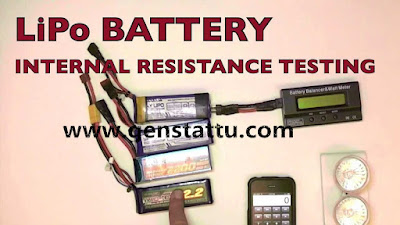IR is a window to the inside of your battery and tell you the overall battery health. It wilt el you how strong or weak it is, how it will perform, and when your battery is sick and dying in need of replacement. OK for Ri to be useful you have to establish a Baseline Reference. To do that certain conditions have to be met in order for the readings to be meaningful and useful. All that means is we are going to start with a new battery, fully charged, well rested, at a specific temperature like room temperature. Don’t worry if the battery is not brand new, you can still do this, it just will not be as meaningful starting with a tired battery because you will not know what it was when at peak or new condition.
A new battery contrary to what you may have heard needs to be broken-in by a few gentle charge discharge cycles. By gentle I mean 1C charge/discharge rate. Take your new battery and fully charge it up at 1C allow it to rest to come to room temp, measure the Ri with your charger, record the reading. Now discharge it down to 3.2 vpc and note AH capacity. Recharge full, rest, measure Ri, and repeat a few times. What you will notice is the Ri will slightly decrease and stabilize, and the AH capacity will slightly increase and stabilize. This is your Baseline Reference of when you battery is new in 100% tip top shape.
How to Measure Internal Resistance in Packs
If you have, for example a 3s 11.1v lipo battery, you need to load it to a couple values to get an accurate internal resistance. First you need to put a relitively small load on the battery, around 1C, and measure the actual current from the battery and the actual voltage across the battery. For a 3-cell 1000 ma battery, you would need to use a load with a value of around 12 ohms. Since the voltage of a freshly charged 3-cell Li-Po is about 12 volts, a 12 ohm load will pull about 1 amp which is 1C for a 1000ma battery. The load will need to dissipate at least 12 watts, so you would need to use a resistor rated for at least 20 watts to keep it from overheating.
Lets say that this test gives you a voltage of 11.20 volts and 0.98 amps of current.
Next you want to load the battery close to it's maximum C rating. To load our gens ace 3s lipo 1000ma battery to 10C we would need to pull 10 amps, since the 3-cell battery loaded down this much will probably have a voltage of around 10 volts, it would take a 1 ohm load to pull 10 amps. 10 amps at 10 volts is 100 watts, so it will take a pretty big resistor to dissipate that much heat. Again you will want to measure the voltage right at the battery and the current being pulled from the battery during this test.
Let's say that in this test we measure 9.97 volts and 10.11 amps. Now that we have these 2 data points, we can calculate the internal drop of the battery and calculate the internal resistance.
The difference in voltage between the 2 tests is 11.20 - 9.97 or 1.23 volts. The difference between the current in these 2 tests is 10.11 - 0.98 or 9.13 amps. Now using Ohms Law, we can calculate the resistance. In this case it would be the voltage difference divided by the current difference or 1.23/9.13 which equals 0.1347 ohms for the entire pack. Dividing this value by 3, since there are 3 cells in the pack, yields an internal resistance of 0.0449 ohms or 44.9 milli-Ohms per cell.
Does LiPos with Higher IR Affect Capacity?
The internal resistance (IR) will not affect the capacity of the pack but rather its capability to deliver at higher rates. Well, here is an example for you. You have a 1000 gallon water tank with a 3" drain valve (low resistance) and a 1/2" drain valve (high resistance). You use this tank to water your 20 horses. The capacity of the tank remains 1000 gallons regardless of which drain valve is open but the 3" valve can water all 20 horses simultaneously while the 1/2" valve can water only 1 horse at a time. Obviously that is not a technical description and there are dozens of factors and exceptions to every rule but that is it in a nutshell without all of the technical jargon.
I have tested one pack that was identical in weight to a "standard" 3S 2200 that delivered over 2800mAh at very high rates (approx 30C) BUT it got very hot.
The verifiable fact is that the IR of LiPo packs will vary enormously with temperature and different packs have different curves. And they may cross. One pack that is physically identical in size and weight to another can have an IR that is much higher at low temperatures (say 20˚C) than the second but that is significantly lower at high temperature (say 60˚C). Yet at the same time their capacity is identical over a range of discharge currents.
Most decent higher capacity and higher discharge rated LiPo cells will have roughly 2 to 6 milliohms (0.002 to 0.006 ohms) of internal resistance when brand new. To calculate the total internal resistance of a series wired pack, you would then add these numbers together so a 4S pack with each cell having 4 milliohms of resistance will show a total internal resistance of about 16 milliohms (0.016 ohms).


没有评论:
发表评论